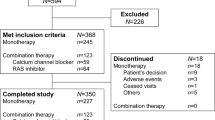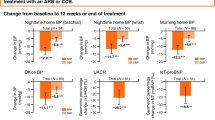Abstract
Cardiovascular risk is subject to circadian variation, with peak morning incidence of myocardial infarction and stroke correlating with the early morning blood pressure (BP) surge (EMBPS). Ideally, antihypertensive therapy should maintain control of BP throughout the 24-h dosing cycle. In two sister studies, Prospective, Randomized Investigation of the Safety and efficacy of Micardis vs Ramipril Using ABPM (ambulatory BP monitoring) (PRISMA) I and II, BP control was compared in patients with essential hypertension (24-h mean baseline ambulatory BP∼148/93 mm Hg) randomized to the angiotensin receptor blocker, telmisartan (80 mg; n=802), or the angiotensin-converting enzyme inhibitor, ramipril (5 or 10 mg; n=811), both dosed in the morning. The primary end point was the change from baseline in mean ambulatory systolic BP (SBP) and diastolic BP (DBP) during the final 6 h of the 24-h dosing cycle. The adjusted mean treatment differences in the last 6-h mean ambulatory SBP/DBP were −5.8/–4.2 mm Hg after 8 weeks and −4.1/–3.0 mm Hg after 14 weeks, in favour of telmisartan (P<0.0001 for all four comparisons). Secondary end point results, including the mean 24-h ambulatory BP monitoring, day- and night-time BP and 24-h BP load, also significantly favoured telmisartan (P<0.0001). Both treatments were well tolerated; adverse events, including cough, were less common with telmisartan. These findings suggest that telmisartan is more effective than ramipril throughout the 24-h period and during the EMBPS; this may be attributable to telmisartan's long duration of effect, which is sustained throughout the 24-h dosing period.
This is a preview of subscription content, access via your institution
Access options
Subscribe to this journal
Receive 12 digital issues and online access to articles
$119.00 per year
only $9.92 per issue
Buy this article
- Purchase on Springer Link
- Instant access to full article PDF
Prices may be subject to local taxes which are calculated during checkout




Similar content being viewed by others
References
Kario K . Morning surge and variability in blood pressure: a new therapeutic target? Hypertension 2005; 45: 485–486.
Kario K . Time for focus on morning hypertension: pitfall of current antihypertensive medication. Am J Hypertens 2005; 18: 149–151.
Marfella R, Siniscalchi M, Nappo F, Gualdiero P, Esposito K, Sasso FC et al. Regression of carotid atherosclerosis by control of morning blood pressure peak in newly diagnosed hypertensive patients. Am J Hypertens 2005; 18: 308–318.
Millar-Craig MW, Bishop CN, Raftery EB . Circadian variation of blood-pressure. Lancet 1978; i: 795–797.
Muller JE, Stone PH, Turi ZG, Rutherford JD, Czeisler CA, Parker C et al. Circadian variation in the frequency of onset of acute myocardial infarction. N Engl J Med 1985; 313: 1315–1322.
Marler JR, Price TR, Clark GL, Muller JE, Robertson T, Mohr JP et al. Morning increase in onset of ischemic stroke. Stroke 1989; 20: 473–476.
Tanaka A, Kawarabayashi T, Fukuda D, Nishibori Y, Sakamoto T, Nishida Y et al. Circadian variation of plaque rupture in acute myocardial infarction. Am J Cardiol 2004; 93: 1–5.
Kario K, Pickering TG, Umeda Y, Hoshide S, Hoshide Y, Morinari M et al. Morning surge in blood pressure as a predictor of silent and clinical cerebrovascular disease in elderly hypertensives: a prospective study. Circulation 2003; 107: 1401–1406.
Kario K, Shimada K, Pickering TG . Clinical implication of morning blood pressure surge in hypertension. J Cardiovasc Pharmacol 2003; 42 (Suppl 1): S87–S91.
Gosse P, Lasserre R, Minifié C, Lemetayer P, Clementy J . Blood pressure surge on rising. J Hypertens 2004; 22: 1113–1118.
Prisant LM . Hypertension and chronotherapy: shifting the treatment paradigm. Am J Hypertens 2001; 14: 277S–279S.
Mallion JM, Baguet JP, Siche JP, Tremel F, de Gaudemaris R . Compliance, electronic monitoring and antihypertensive drugs. J Hypertens 1998; 16 (Suppl 1): S75–S79.
Fujii J, Seki A . Compliance and compliance-improving strategies in hypertension: the Japanese experience. J Hypertens Suppl 1985; 3 (1): S19–S22.
Morgan T, Anderson A, Jones E . The effect on 24 h blood pressure control of an angiotensin converting enzyme inhibitor (perindopril) administered in the morning or at night. J Hypertens 1997; 15: 205–221.
Lacourcière Y, Krzesinski JM, White WB, Davidai G, Schumacher H . Sustained antihypertensive activity of telmisartan compared with valsartan. Blood Press Monit 2004; 9: 203–210.
White WB, Lacourcière Y, Davidai G . Effects of the angiotensin II receptor blockers telmisartan versus valsartan on the circadian variation of blood pressure: impact on the early morning period. Am J Hypertens 2004; 17: 347–353.
Mann JF, Gerstein HC, Pogue J, Bosch J, Yusuf S . Renal insufficiency as a predictor of cardiovascular outcomes and the impact of ramipril: the HOPE randomized trial. Ann Intern Med 2001; 134: 629–636.
Williams B, Gosse P, Lowe L, Harper R, PRISMA I Study Group. The prospective, randomized investigation of the safety and efficacy of telmisartan versus ramipril using ambulatory blood pressure monitoring (PRISMA I). J Hypertens 2006; 24: 193–200.
Lacourcière Y, Neutel JM, Davidai G, Koval S . A multicenter, 14-week study of telmisartan and ramipril in patients with mild-to-moderate hypertension using ambulatory blood pressure monitoring. Am J Hypertens 2006; 19: 104–112.
American Society of Hypertension. Recommendations for routine blood pressure measurement by indirect cuff sphygmomanometry. Am J Hypertens 1992; 5: 207–209.
Stangier J, Schmid J, Türck D, Switek H, Verhagen A, Peeters PA et al. Absorption, metabolism, and excretion of intravenously and orally administered [14C]telmisartan in healthy volunteers. J Clin Pharmacol 2000; 40: 1312–1322.
Stangier J, Su CAPF, Roth W . Pharmacokinetics of orally and intravenously administered telmisartan in healthy young and elderly volunteers and in hypertensive patients. J Int Med Res 2000; 28: 149–167.
Meisel S, Shamiss A, Rosenthal T . Clinical pharmacokinetics of ramipril. Clin Pharmacokinet 1994; 26: 7–15.
Ding PY, Chu KM, Chiang HT, Shu KH . A double-blind ambulatory blood pressure monitoring study of the efficacy and tolerability of once-daily telmisartan 40 mg in comparison with losartan 50 mg in the treatment of mild-to-moderate hypertension in Taiwanese patients. Int J Clin Pract Suppl 2004; 58: 16–22.
Smith DH, Cramer MJ, Neutel JM, Hettiarachchi R, Koval S . Comparison of telmisartan versus losartan: meta-analysis of titration-to-response studies. Blood Press Monit 2003; 8: 111–117.
Lacourcière Y, Asmar R . A comparison of the efficacy and duration of action of the angiotensin II receptor blocker telmisartan to amlodipine. Am J Hypertens 1999; 12: 1181–1187.
Ragot S, Ezzaher A, Meunier A, Poterre M, Bourkaib R, Herpin D . Comparison of trough effect of telmisartan vs perindopril using self blood pressure measurement: EVERESTE study. J Hum Hypertens 2002; 16: 865–873.
Suzuki H, Kanno Y, Nakamoto H, Okada H, Sugahara S . Decline of renal function is associated with proteinuria and systolic blood pressure in the morning in diabetic nephropathy. Clin Exp Hypertens 2005; 27: 129–138.
Redón J, Roca-Cusachs A, Mora-Macia J . Uncontrolled early morning blood pressure in medicated patients: the ACAMPA study. Analysis of the control of blood pressure using ambulatory blood pressure monitoring. Blood Press Monit 2002; 7: 111–116.
Clement DL, De Buyzere ML, De Bacquer DA, de Leeuw PW, Duprez DA, Fagard RH, Gheeraert PJ et al. Prognostic value of ambulatory blood-pressure recordings in patients with treated hypertension. N Engl J Med 2003; 348: 2407–2415.
Lewington S, Clarke R, Qizilbash N, Peto R, Collins R, Prospective Studies Collaboration. Age-specific relevance of usual blood pressure to vascular mortality: a meta-analysis of individual data for one million adults in 61 prospective studies. Lancet 2002; 360: 1903–1913.
The ONTARGET Investigators. Telmisartan, ramipril, or both in patients at high risk for vascular events. N Engl J Med 2008; 358: 1547–1559.
Neutel J, Smith DH . Evaluation of angiotensin II receptor blockers for 24-hour blood pressure control: meta-analysis of a clinical database. J Clin Hypertens 2003; 5: 58–63.
Wolf-Maier K, Cooper RS, Kramer H, Banegas JR, Giampaoli S, Joffres MR et al. Hypertension treatment and control in five European countries, Canada, and the United States. Hypertension 2004; 43: 10–17.
Smith DH, Neutel JM, Lacourcière Y, Kempthorne-Rawson J . Prospective, randomized, open-label, blinded-endpoint (PROBE) designed trials yield the same results as double-blind, placebo-controlled trials with respect to ABPM measurements. J Hypertens 2003; 21: 1291–1298.
The Heart Outcomes Prevention Evaluation Study Investigators. Effects of an angiotensin-converting-enzyme inhibitor, ramipril, on cardiovascular events in high-risk patients. N Engl J Med 2000; 342: 145–153.
Acknowledgements
The PRISMA study programme was investigator-led, and was supported by a research grant from Boehringer Ingelheim.
Author information
Authors and Affiliations
Corresponding author
Rights and permissions
About this article
Cite this article
Williams, B., Lacourcière, Y., Schumacher, H. et al. Antihypertensive efficacy of telmisartan vs ramipril over the 24-h dosing period, including the critical early morning hours: a pooled analysis of the PRISMA I and II randomized trials. J Hum Hypertens 23, 610–619 (2009). https://doi.org/10.1038/jhh.2009.4
Received:
Revised:
Accepted:
Published:
Issue Date:
DOI: https://doi.org/10.1038/jhh.2009.4
Keywords
This article is cited by
-
Telmisartan: clinical evidence across the cardiovascular and renal disease continuum
Drugs & Therapy Perspectives (2017)
-
Blood pressure variability over 24 h: prognostic implications and treatment perspectives. An assessment using the smoothness index with telmisartan–amlodipine monotherapy and combination
Hypertension Research (2014)
-
Olmesartan vs. Ramipril in Elderly Hypertensive Patients: Review of Data from Two Published Randomized, Double-Blind Studies
High Blood Pressure & Cardiovascular Prevention (2014)
-
Effect of placebo on ambulatory blood pressure monitoring in children
Pediatric Nephrology (2012)



